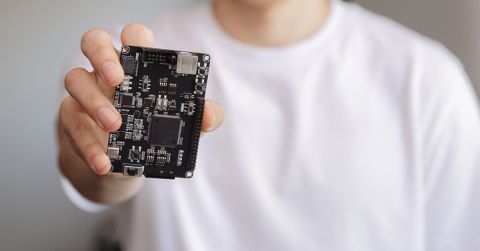Processing Power for Automotive Telematics Systems

Most tech experts believe that everyone will be using telematics in just a couple years. From an informatics perspective, the data gathered by automotive telematics systems will be instrumental in improving safety systems, performance, and your overall driving experience. On the telecom side, automotive telematics systems that are integrated with the cars V2X network allow sharing of data between vehicles in order to improve safety measures. This will be required to an even greater degree as vehicles become more autonomous.
The terminology of telematics can be a bit misleading. This is mostly because the term is used for a wide variety of technologies and vehicle systems. So, let’s simplify this:
-
By definition, telematics is just about any technology that receives, stores, and sends signals which are, in turn, used for remote control over other devices.
-
Automotive telematics systems include advanced technologies that can be used to improve control over your vehicle, ranging from simple touchscreen display inclusions to advanced traffic assistance.
As automotive telematics systems are now integrated with standard GPS modules, companies with a vehicle fleet can more easily track their assets when a telematics systems is installed in the vehicle. These systems come in the integrated and aftermarket varieties. If you’re looking for components that you can use for automotive telematics systems, you should start with your processing power as this will determine which other components your system will require.
Technology & Capabilities
There are many different types of automotive telematics systems. The not-so-subtle differences are determined by which technologies are included in an individual system. In addition to the processing power you include in your system, you should consider including the following features:
-
GPS/GNSS tracking: If a GPS/GNSS module is not integrated into your vehicle as a standard feature, then you should consider including this at the hardware level on your telematics system. Otherwise, you can gather the GPS data directly from an ECU in the vehicle. This will need to be implemented at the software/firmware level.
-
Wireless communication: For live vehicle tracking, you’ll need to include cellular access (3G or LTE Cat-M1) for wireless communication. For shorter range access to the system for data retrieval, WCDMA, HSPA+, or Bluetooth are options for communication. An open protocol like LoRaWAN could, theoretically, be used for automotive telematics systems, although it becomes unusable for certain fleet vehicles that travel over very long range.
If you are not using a wireless protocol for data retrieval, then you will need to include a USB port to access data and download it to a PC. The remaining informatics capabilities required for telematics systems are implemented at the software level.
NXP Semiconductors, FS32K148HFT0VLQT
The FS32K148HFT0VLQT MCU is a 32-bit technology based on Arm® Cortex®-M4F and Cortex-M0+ in an LQFP package. This module is designed for general automotive usage, as well as being scalable to other systems. It comes with an integrated communication interface, a 23-pin ECU connector, 8 MB flash memory, CSEC hardware security, ASIL B, ISO 26262 functional safety, and many more features. NXP has integrated this particular MCU in their S32K148 T-Box system. This system plugs into the standard OBD-II port in a vehicle.
 The S32K148-T-BOX automotive telematics module
The S32K148-T-BOX automotive telematics module
NXP Semiconductors, SPC5123YVY400B
The SPC5123YVY400B MCU from NXP Semiconductors is an automotive-grade MCU that is adaptable to automotive telematics applications. This 32-bit MCU has a high level of adaptability for different automotive systems beyond telematics, which brings a higher price point than the previous MCU.
 Simplified block diagram for the SPC5123YVY400B, from the datasheet
Simplified block diagram for the SPC5123YVY400B, from the datasheet
Analog Devices, ADSP-BF532SBBCZ400 Blackfin Car Telematics
Analog Devices’ Blackfin Car Telematics Platform (CTP) is considered to be extremely innovative when it comes to the automotive telematics systems industry. This system runs on the ADSP-BF532SBBCZ400 SoC. This 16-bit chip is available in LQFP and BGA-mounted packages. The open-expandable network enables users to enjoy next-generation telematics with advanced features:
The Blackfin CTP includes a collection of telematics function modules that reduce code-development time and enable faster time-to-market. These third-party products offer a broad range of application and development software—products and tools that help telematics systems designers accelerate their development efforts and cut time to market through ease of development, reusability, and openness, as well as substantially reduced risk and cost. [Source: Blackfin whitepaper]
 Comparison of existing automotive telematics systems and a system based on Blackfin CTP. From the [Blackfin whitepaper]
Comparison of existing automotive telematics systems and a system based on Blackfin CTP. From the [Blackfin whitepaper]
Freematics ONE+
If you’re a believer in open-source hardware, then the Freematics ONE+ is a powerful option that you can use as a basis for your next telematics system. This system is custom-programmable, although the default settings are extremely easy to access and understand. The Freematics ONE+ system connects to the vehicle by plugging into the OBD-II port. It functions as a standalone smart device that can communicate with the outside network as well as the actual vehicle. Useful technologies included are a GNSS receiver, motion sensor, internal flash memory for storage, and an integrated accelerometer.
 Freematics ONE+ open-source system
Freematics ONE+ open-source system
An integrated automotive telematics system provides the embedded processing capabilities you need for data acquisition from all systems in your vehicle. There are other components you’ll need to include if you are looking to build automotive telematics systems.
Liked this article? Stay up-to-date with our latest articles by signing up for our newsletter.








